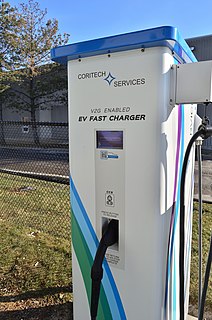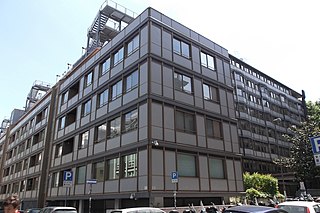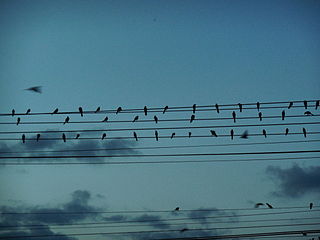
Energy storage is the capture of energy produced at one time for use at a later time to reduce imbalances between energy demand and energy production. A device that stores energy is generally called an accumulator or battery. Energy comes in multiple forms including radiation, chemical, gravitational potential, electrical potential, electricity, elevated temperature, latent heat and kinetic. Energy storage involves converting energy from forms that are difficult to store to more conveniently or economically storable forms.
Distributed generation, also distributed energy, on-site generation (OSG), or district/decentralized energy, is electrical generation and storage performed by a variety of small, grid-connected or distribution system-connected devices referred to as distributed energy resources (DER).

Pumped-storage hydroelectricity (PSH), or pumped hydroelectric energy storage (PHES), is a type of hydroelectric energy storage used by electric power systems for load balancing. The method stores energy in the form of gravitational potential energy of water, pumped from a lower elevation reservoir to a higher elevation. Low-cost surplus off-peak electric power is typically used to run the pumps. During periods of high electrical demand, the stored water is released through turbines to produce electric power. Although the losses of the pumping process make the plant a net consumer of energy overall, the system increases revenue by selling more electricity during periods of peak demand, when electricity prices are highest. If the upper lake collects significant rainfall or is fed by a river then the plant may be a net energy producer in the manner of a traditional hydroelectric plant.

Tenaga Nasional Berhad, also known as Tenaga Nasional or simply Tenaga, is the Malaysian multinational electricity company and is the only electric utility company in Peninsular Malaysia and also the largest publicly-listed power company in Southeast Asia with MYR 99.03 billion worth of assets. It serves over 8.4 million customers throughout Peninsular Malaysia and the East Malaysian state of Sabah through Sabah Electricity Sdn Bhd. TNB's core activities are in the generation, transmission and distribution of electricity. Other activities include repairing, testing and maintaining power plants, providing engineering, procurement and construction services for power plants related products, assembling and manufacturing high voltage switchgears, coal mining and trading. Operations are carried out in Malaysia, Mauritius, Pakistan, India and Indonesia.

Grid energy storage is a collection of methods used for energy storage on a large scale within an electrical power grid. Electrical energy is stored during times when electricity is plentiful and inexpensive or when demand is low, and later returned to the grid when demand is high, and electricity prices tend to be higher.

Vehicle-to-grid (V2G), also known as Vehicle-to-home (V2H) or Vehicle-to-load (V2L) describes a system in which plug-in electric vehicles (PEV) sell demand response services to the grid. Demand services are either delivering electricity or by reducing their charging rate. Demand services reduce pressure on the grid, which might otherwise experience disruption from load variations.
KEMA NV, established in 1927, is a global energy consultancy company headquartered in Arnhem, Netherlands. It offers management consulting, technology consulting & services to the energy value chain that include business and technical consultancy, operational support, measurements & inspection, and testing & certification services.

Enel S.p.A. is an Italian multinational manufacturer and distributor of electricity and gas. Enel, which originally stood for Ente nazionale per l'energia elettrica, was first established as a public body at the end of 1962, and then transformed into a limited company in 1992. In 1999, following the liberalisation of the electricity market in Italy, Enel was privatised. The Italian state, through the Ministry of Economy and Finance, is the main shareholder, with 23.6% of the share capital as of 1 April 2016.

Endesa, S.A. is a Spanish multinational electric utility company, the largest in the country. The firm, a majority-owned subsidiary of the Italian utility company Enel, has 10 million customers in Spain, with domestic annual generation of over 97,600 GWh from nuclear, fossil-fueled, hydroelectric, and renewable resource power plants. Internationally, it serves another 10 million customers and provides over 80,100 GWh annually. Total customers numbered 22.2 million as of December 31, 2004. It also markets energy in Europe. The company has additional interests in Spanish natural gas and telecommunications companies.
A virtual power plant (VPP) is a cloud-based distributed power plant that aggregates the capacities of heterogeneous distributed energy resources (DER) for the purposes of enhancing power generation, as well as trading or selling power on the electricity market. Examples of virtual power plants exist in the United States, Europe, and Australia.

Pico hydro is a term used for hydroelectric power generation of under 5 kW. These generators have proven to be useful in small, remote communities that require only a small amount of electricity – for example, to power one or two fluorescent light bulbs and a TV or radio in 50 or so homes. Even smaller turbines of 200–300 W may power a single home with a drop of only 3.28 feet (1.00 m). Pico-hydro setups typically are run-of-stream, meaning that a reservoir of water is not created, only a small weir is common, pipes divert some of the flow, drop this down a gradient, and through the turbine before being exhausted back to the stream.

Nicaragua is the country in Central America with the lowest electricity generation, as well as the lowest percentage of population with access to electricity. The unbundling and privatization process of the 1990s did not achieve the expected objectives, resulting in very little generation capacity added to the system. This, together with its high dependence on oil for electricity generation, led to an energy crisis in 2006 from which the country has not fully recovered yet.
DESERTEC is a foundation that promotes the production of renewable energy in deserts. The project aims at creating a global renewable energy plan based on the concept of harnessing sustainable powers from sites where renewable sources of energy are more abundant and transferring it through high-voltage direct current transmission to consumption centers. The foundation also works on concepts involving green hydrogen. Multiple types of renewable energy sources are envisioned, but the natural climate of the deserts is key to creating the plan.
Terna S.p.A. is a transmission system operator (TSO) based in Rome, Italy. It operates through Terna Rete Italia, that manages the Italian transmission grid and Terna Plus which is in charge of new business opportunities and non-traditional activities in Brazil, Uruguay, Peru and Chile (2021). With 74,855 kilometres (46,513 mi) of power lines or around 98% of the Italian high-voltage power transmission grid, Terna is the sixth largest electricity transmission grid operator in the world based on the size of its electrical grid. Terna is listed on the Borsa Italiana and is a constituent of the FTSE MIB index.

An electrical grid is an interconnected network for electricity delivery from producers to consumers. Electrical grids vary in size and can cover whole countries or continents. It consists of:

Enel Green Power S.p.A. is an Italian multinational renewable energy corporation, headquartered in Rome. The company was formed as a subsidiary of the power generation firm Enel in December 2008. It is present with assets in operation or under construction in 21 countries and carries out development activities in a further 5 countries on five continents generating energy from hydropower, wind, solar and geothermal sources. As of 2021, it manages a capacity of 54,2 GW and has over 1200 plants worldwide. From 4 November 2010 to 31 March 2016, the company was listed on the FTSE MIB index of the Milan Stock Exchange, as well as on the Madrid Stock Exchange and the Barcelona, Bilbao, and Valencia regional Stock Exchanges.
Italy's total electricity consumption was 302.75 terawatt-hour (TWh) in 2020, of which 270.55 TWh (89.3%) was produced domestically and the remaining 10.7% was imported.

A photovoltaic power station, also known as a solar park, solar farm, or solar power plant, is a large-scale grid-connected photovoltaic power system designed for the supply of merchant power. They are differentiated from most building-mounted and other decentralised solar power because they supply power at the utility level, rather than to a local user or users. The generic expression utility-scale solar is sometimes used to describe this type of project.
The Fraunhofer Institute for Solar Energy Systems ISE is an institute of the Fraunhofer-Gesellschaft. Located in Freiburg, Germany, The Institute performs applied scientific and engineering research and development for all areas of solar energy. Fraunhofer ISE has three external branches in Germany which carry out work on solar cell and semiconductor material development: the Laboratory and Service Center (LSC) in Gelsenkirchen, the Technology Center of Semiconductor Materials (THM) in Freiberg, and the Fraunhofer Center for Silicon Photovoltaics (CSP) in Halle. Since 2006, Prof. Dr. Eicke R. Weber is the director of Fraunhofer ISE. With over 1,100 employees, Fraunhofer ISE is the largest institute for applied solar energy research in Europe. The 2012 Operational Budget including investments is 74.3 million euro.
In 2018 Chile produced about 7% of its electricity from solar power. As of year end, it had 2137 MW of solar PV capacity. In July 2020 installed solar capacity had risen to 3104 MW, with another 2801 MW under construction. At the end of 2021 Chile was ranked 22nd in the world in terms of installed solar energy.













